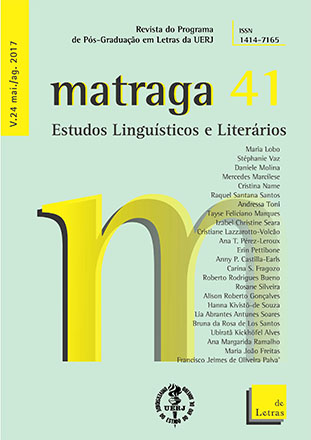Prosodic patterns and <i>input</i> in language acquisition
DOI:
https://doi.org/10.12957/matraga.2017.28708Keywords:
acquisition of word stress patterns, input, frequency of useAbstract
The majority of studies dealing with the prosodic template of first words in the past decades found a trochaic (strong-weak) tendency across languages. One line of explanation for this tendency is that trochees result from a left default value for the parameter nucleus of the foot (e.g. DRESHER 1992, FIKKERT 1994). However, as most of these studies discussed languages that are trochaic in adult form (e.g. English, Dutch), it is difficult to tease apart if the early trochees are due to this default value or if they just reflect the pattern of the target language. Furthermore, some studies have shown that is not the case that children always present a trochaic tendency (e.g. DEMUTH 1996). In this regard, Brazilian Portuguese (BP) becomes a very interesting language to analyze. On the one hand, it has more trochees than iambs (weak-strong) in adult speech. On the other hand, children begin producing more iambs than trochees (e.g. SANTOS 2001, 2007, BONILHA 2005, BAIA 2008). One could claim that this unexpected iambic tendency in early BP is consistent with the frequency of multisyllabic words in the ambient language (e.g. KEHOE 1999, ROARK & DEMUTH 2000, PRIETO 2006). In this paper we put this alternative explanation to test, by analyzing data from 2 BP speaking children (from 1;3 to 3;6 years old) and their caretakers. If this child directed speech (FDC) approach is correct, we should expect to find more iambs than trochees in FDC, given that previous analyses of BP speaking children’s data found an iambic tendency. The results show that FDC actually has a different distributional pattern than adult language, but trochees still outnumber iambs. Furthermore, children’s production has a different pattern than CDS. Therefore, FDC cannot explain the early prosodic patterns of BP either. Additionally, the results showed that children are not avoiding any specific prosodic pattern in their selection. Moreover, it is also not the case that children avoid some patterns in their production. In conclusion, our results clearly discard the hypotheses that children’s initial prosodic patterns reflect FDC’s distributional patterns.
---
DOI: http://dx.doi.org/10.12957/matraga.2017.28708
Downloads
Downloads
Published
How to Cite
Issue
Section
License
Authorization
Matraga – Scientific Journal of the Post-graduate Program in Arts and Humanities of UERJ is authorized to publish the article submitted here, if it is accepted for online publication. It is attested that the contribution is original, that it is not being submitted to another publisher for publication, and that this statement is the expression of truth.
The works published in Matraga's virtual space – Scientific Journal of the Post-graduate Program in Arts and Humanities of UERJ will be automatically transferred, and your copyright is reserved to Matraga. Its reproduction, in whole or in part, is conditional on the citation of the authors and the data of the publication.

Matraga uses license Creative Commons - Attribution-Non-Commercial 4.0 International.





